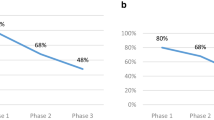Abstract
This chapter focuses on the TSM clinical changes to role reversal when doing experiential work with people affected by trauma (Hudgins, Experiential treatment for PTSD: The therapeutic spiral model. Springer Publishing Company, 2002; Hudgins and Toscani, Healing world trauma with the therapeutic spiral model: Psychodramatic stories from the frontlines, pp 49–74, 2013). Zerka Moreno (The quintessential Zerka: Writings by Zerka Toeman Moreno on psychodrama, sociometry and group psychotherapy. First issued in paperback, Routledge, pp 289–301, 2006) believed in the power of the double due to her early work with her sister. It was JL Moreno who believed in the power of role reversing to gain someone else's viewpoint in interpersonal relationships (Giacomucci and Marquit, Frontiers in Psychology 11:896, 2020). The therapeutic spiral model is indebted to Moreno (Who shall survive? Foundations of sociometry, group psychotherapy and socio-drama. Beacon House, 1953) child development theory and incorporates the stages of role development into clinical role reversals. The trauma survivor’s internal role atom (Hudgins, Why global health matters: How to (Actually) make the world a better place, pp 286–324, 2017) is a clinical map for trauma-informed psychodrama and the use of experiential interventions that informs the use of role reversals in TSM psychodrama with trauma. This chapter focuses on the TSM clinical changes to role reversal when demonstrating experiential work with people affected by trauma. Starting with a prescriptive role of strength, TSM does a role reversal with personal, interpersonal, and transpersonal strengths to increase spontaneity and help establish the connection to the autonomous healing center. Next, we explore how TSM utilizes role reversals with the internalized roles of the TSM trauma triangle—victim, perpetrator, and abandoning authority. We present a step-by-step structured approach for the enactment of both victim and perpetrator roles that follows the stages of role development—role taking, role playing, and role creating—to prevent re-traumatization and uncontrolled catharsis, providing adequate containment and support to re-experience trauma-based roles consciously.
Access this chapter
Tax calculation will be finalised at checkout
Purchases are for personal use only
Similar content being viewed by others
References
American Psychiatric Association. (Ed.). (2013). Diagnostic and statistical manual of mental disorders (5th ed.). American Psychiatric Association.
Blatner, A. (1996). Acting-In: Practical applications of psychodramatic methods (3rd ed.). Springer Publishing Company.
Carnabucci, K., & Ciotola, L. (2013). Healing eating disorders with psychodrama and other action methods: Beyond the silence and the fury (1st ed.). Jessica Kingsley Publishers.
Giacomucci, S., & Marquit, J. (2020). The effectiveness of trauma-focused psychodrama in the treatment of PTSD in inpatient substance abuse treatment. Frontiers in Psychology, 11, 896. https://doi.org/10.3389/fpsyg.2020.00896
Hudgins, K. (2002). Experiential treatment for PTSD: The therapeutic spiral model. Springer Publishing Company.
Hudgins, K. (2017). PTSD unites the world: Prevention, intervention, and training with the therapeutic spiral model. In C. E. Stout (Ed.), Why global health matters: How to (Actually) make the world a better place (pp. 286–324).
Hudgins, K., & Toscani, F. (2013). The similarities and differences between classical psychodrama and the therapeutic spiral model. In K. Hudgins & F. Toscani (Eds.), Healing world trauma with the therapeutic spiral model: Psychodramatic stories from the frontlines (pp. 49–74). http://www.123library.org/book_details/?id=58841
Moreno, J. L. (1953). Who shall survive? Foundations of sociometry, group psychotherapy and socio-drama (2nd ed.). Beacon House.
Moreno, Z. T. (2006). The function of “Tele” in human relations. In T. Horvatin & E. Schreiber (Eds.), The quintessential Zerka: Writings by Zerka Toeman Moreno on psychodrama, sociometry and group psychotherapy (First issued in paperback, pp. 289–301). Routledge.
Author information
Authors and Affiliations
Corresponding author
Rights and permissions
Copyright information
© 2022 The Author(s), under exclusive license to Springer Nature Singapore Pte Ltd.
About this chapter
Cite this chapter
Hudgins, K., Durost, S.W. (2022). The Safe Use of Role Reversal for Trauma-Informed TSM Psychodrama. In: Experiential Therapy from Trauma to Post-traumatic Growth. Psychodrama in Counselling, Coaching and Education, vol 2. Springer, Singapore. https://doi.org/10.1007/978-981-19-3175-8_9
Download citation
DOI: https://doi.org/10.1007/978-981-19-3175-8_9
Published:
Publisher Name: Springer, Singapore
Print ISBN: 978-981-19-3174-1
Online ISBN: 978-981-19-3175-8
eBook Packages: Behavioral Science and PsychologyBehavioral Science and Psychology (R0)




